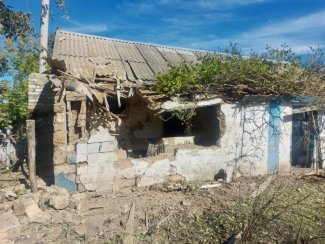Mobilisation chaos in Russia. 214th day of the war

The mobilisation in Russia announced on 21 September, is being implemented hurriedly, with military commissions failing to adhere to its guidelines for conscripting reservists only of specific specialities. The organisational problems are evidenced by a letter from the chairman of Russia’s Human Rights Council, Valery Fadeyev, to Defence Minister Sergei Shoigu on 24 September, asking him to resolve the mobilisation problems urgently. It writes that the first days of partial mobilisation have shown that military commissariats do not have a conscription plan, have old, unverified databases and do not exempt from appointment people who, according to the rules, should get a deferral. Several governors have also confirmed the trouble with mobilisation, while in Crimea, it has been used as a repressive measure against Crimean Tatars, with 1,500 men being called up.
Deputy Head of the Main Operational Directorate of the General Staff of the Armed Forces of Ukraine, Oleksiy Hromov, reported that, according to preliminary estimates, Russian conscription would occur in at least two stages. In the first, presumably within a month and a half, the enemy plans to complete the military units taking part in combat operations to full strength. It is not ruled out that some of those mobilised will be used to supplement the border service of the Federal Security Service.
The Donbas remains the main arena of fighting. Russian forces have approached Bakhmut from the northeast but are being repulsed on its outskirts. Further attempts to advance on this town from the east and Ukrainian positions south of it have also failed. Fighting continues for towns northeast of Bakhmut, south and southeast of Siversk and north of Horlivka. After a break of several days, Russian forces have resumed their offensive in the western part of Donetsk Oblast. In turn, the defenders repulsed further attacks north and west of Donetsk and renewed attacks in the Lyman area. They also recaptured the town of Yats’kivka near the border with the Kharkiv Oblast and, according to some sources, were also to encircle two enemy battalions in the village of Drobysheve. The Russian offensive on the eastern outskirts of Kupiansk was unsuccessful.
Russian artillery and aviation continued to shell and bombard Ukrainian army positions and facilities along the contact line (Avdiivka was the target of massive shelling) and in the border areas of the Chernihiv and Sumy oblasts. Kharkiv and the areas of the Kharkiv Oblast recaptured at the beginning of September, and the Nikopol and Synelnykove raions of the Dnipropetrovsk Oblast, Mykolaiv, Ochakiv and Zaporizhzhia (the city was one of the main targets of rocket attacks for the next few days), together with villages southeast of it, are under attack. With cruise munitions purchased in Iran, the Russians attacked targets in and around Odesa. Russian positions and facilities in the Kherson Oblast (including the Kakhovka bridge and crossings in the Nova Kakhovka area) remain the main targets of the defenders’ artillery and aviation. Ukrainian saboteurs have carried out attacks around Mariupol, Berdiansk and Melitopol.
‘Annexation referendums’ are ongoing in the occupied territories. They are scheduled to conclude on 27 September, but already two days earlier, the organisers reported that the turnout exceeded 50 per cent, meaning that the referendums were considered ‘valid’. The vote collection process resembles a special operation: in the occupied territories of the Kherson and Zaporizhzhia oblasts, mobile ballot boxes protected by soldiers were circulated the villages. The Russians are unable to guarantee the security of the referendum. There have been acts of sabotage in Melitopol, Kherson and Berdiansk (explosions of explosives near the seats of collaborating authorities), and ongoing Ukrainian rocket and artillery fire has disorganised the work of some polling stations. Voting is often enforced under the threat of losing jobs or social benefits, and there have also been cases of one person casting multiple votes on behalf of family members.
Kyiv has taken legal steps to prove that the organisation of the so-called referendums is illegal. On 23 September, the Prosecutor General’s Office opened criminal proceedings over the holding of referendums in Donetsk, Luhansk, Zaporizhzhia and Kherson oblasts. At the pre-trial stage, documentation is collected, and the involvement in illegal activities of more than 4,000 people involved in the organisation of the vote is verified. On the same day, President Volodymyr Zelensky called on residents of the occupied territories to provide the Ukrainian special services with any data on the organisers of the pseudo-referendum, as well as on the progress of Russian mobilisation.
The Special Operations Forces and the State Border Guard Service of Ukraine warned that the likelihood of Russian use of diversionary groups operating from Belarusian territory is increasing. It was revealed that 130 armed mercenaries from the ‘private’ military company ‘Liga’ had arrived in Minsk on 20 September. They were to be equipped with 300 Ukrainian military uniforms and deployed in a facility belonging to the security company GardService, which is linked to the Belarusian power bloc. Kyiv does not rule out that the diversionary groups, supplemented by ‘volunteers’ from Belarus, could be used on the territory of the Volyn, Rivne, Zhytomyr and Kyiv oblasts.
Germany has handed over to Ukraine the last six of the promised 30 Gepard self-propelled anti-aircraft guns, along with 6,000 rounds of ammunition for them, which is about 1.5 fire units for each gun (the ammunition stock for the 35 mm cannons mounted on the Gepard is 640 rounds, allowing just over a minute of continuous fire).
Commentary
- Conscription is chaotic, and one gets the impression that it often even takes the form of a round-up in order to get the plan done as quickly as possible. The first days of mobilisation have caused concern among the Russians. This is confirmed, among other things, by a Kremlin spokesman who admitted that the ‘hysterical and emotional reactions of part of the population were due to a lack of comprehensive information from the Ministry of Defence. Local authorities are also signalling shortcomings in the work of the military commissions, which is worsening public sentiment and regard the desire to implement the conscription plan as soon as possible as a worrying development.
- The central authorities face the challenge of preventing evasion of service – according to unconfirmed official information, more than 250,000 men have left Russia since 21 September. It is not ruled out that the authorities will decide to ban or place far-reaching restrictions on men going abroad. Another challenge is to curb the growth of anti-mobilisation sentiment fuelled by news of the destruction of military commission premises. To calm the mood, the authorities may decide to reduce the pace of mobilisation action and/or restrict the criticised recruitment procedure without considering the individual predispositions of those being mobilised.





